
Senecio is a genus of flowering plants in the daisy family (Asteraceae) that includes ragworts and groundsels.

Jasmine is a genus of shrubs and vines in the olive family of Oleaceae. It contains around 200 species native to tropical and warm temperate regions of Eurasia, Africa, and Oceania. Jasmines are widely cultivated for the characteristic fragrance of their flowers. Additionally a number of unrelated species of plants or flowers contain the word "jasmine" in their common names.

Toona, commonly known as redcedar, toon or toona, tooni is a genus in the mahogany family, Meliaceae, native from Afghanistan south to India, and east to North Korea, Papua New Guinea and eastern Australia. In older texts, the genus was often incorporated within a wider circumscription of the related genus Cedrela, but that genus is now restricted to species from the Americas.
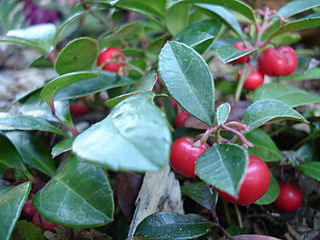
Gaultheria procumbens, also called the eastern teaberry, the checkerberry, the boxberry, or the American wintergreen, is a species of Gaultheria native to northeastern North America from Newfoundland west to southeastern Manitoba, and south to Alabama. It is a member of the Ericaceae.

Sanvitalia ), the creeping zinnias, is a genus of flowering plants belonging to the family Asteraceae. They are native to mostly to Mexico, with a few species in Central America, South America, and the Southwestern United States.

Physocarpus, commonly called ninebark, is a genus of flowering plants in the family Rosaceae, native to North America and northeastern Asia.
Germplasm Resources Information Network or GRIN is an online USDA National Genetic Resources Program software project to comprehensively manage the computer database for the holdings of all plant germplasm collected by the National Plant Germplasm System.

Heliopsis is a genus of herbaceous flowering plants in the family Asteraceae, native to dry prairies in North and South America. The sunflower-like composite flowerheads are usually yellow, up to 8 cm (3 in) in diameter, and are borne in summer. Species are commonly called ox-eye or oxeye.

Sisyrinchium montanum, the blue-eyed-grass, American blue-eyed-grass, or strict blue-eyed grass, is a grass-like species of plant from the genus Sisyrinchium, native to northern North America from Newfoundland west to easternmost Alaska, and south to Pennsylvania in the east, and to New Mexico in the Rocky Mountains. It has also been introduced to parts of France, likely during the First World War.
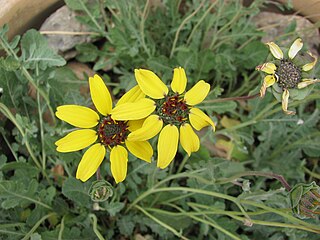
Berlandiera is a genus of flowering plants in the family Asteraceae.

Tetrachondraceae is a plant family in the order Lamiales. The family contains the two genera Polypremum and Tetrachondra, which together comprise the three species:
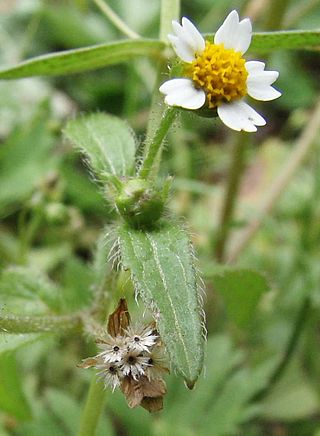
Galinsoga quadriradiata is a species of flowering plant in the family Asteraceae which is known by several common names, including shaggy soldier, Peruvian daisy, hairy galinsoga. Its native home is apparently central Mexico, although it has become naturalized in many other places.
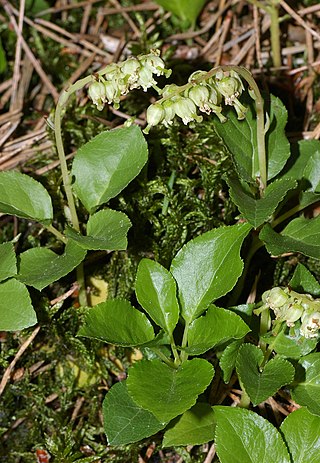
Orthilia is a genus of flowering plants in the family Ericaceae. It has only one species, Orthilia secunda. Its common names are sidebells wintergreen, one-sided-wintergreen and serrated-wintergreen. It is also called one-sided pyrola, one-sided shinleaf, and one-sided wintergreen. It was previously part of genus Pyrola, the wintergreens.

Sanvitalia procumbens with the common name of Mexican creeping zinnia is the type species of the genus Sanvitalia and a member of the family Asteraceae and tribe Heliantheae.

Melanthera, is a genus of perennial flowering plants in the family Asteraceae, native to North and South America, as well as Africa, Asia and Oceania, including Hawaiʻi.

Sagina procumbens is a species of flowering plant. in the family Caryophyllaceae known by the common names procumbent pearlwort, birdeye pearlwort and matted pearlwort. It can be found throughout the Northern Hemisphere and parts of South America. It is a common weed of many environments. It can be found in wild and disturbed habitat, especially moist areas. It can sometimes be seen growing in lawns or in cracks in pavements. This is a perennial herb forming clumps or mats of hairless green herbage, sometimes vaguely resembling a patch of moss. The leaves are linear and up to 1 or 2 centimeters long. The inflorescence is a solitary flower with four or five sepals and four or five small white petals, but the petals are sometimes absent.
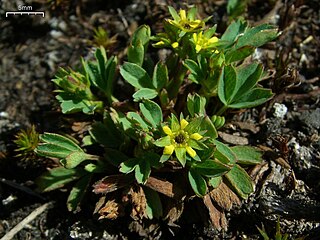
Sibbaldia procumbens is a species of flowering plant of the genus Sibbaldia in the rose family. It has an Arctic–alpine distribution; it can be found throughout the Arctic, as well as at higher elevations in the mountains of Eurasia and North America. It grows on tundra and in alpine climates where snow remains year-round, and on subalpine mountain slopes. This is a low, mat-forming perennial herb producing clumps of herbage in rocky, gravelly substrate. A spreading stem up to 15 centimeters long grows from a caudex. Each leaf is divided into usually three leaflets borne at the end of a petiole up to 7 centimeters long. Each wedge-shaped leaflet has three teeth at the tip. The flower has usually five pointed green bractlets, five wider pointed green sepals, and five tiny yellowish petals each about a millimeter long. The fruits develop in the remnants of the sepals on erect stalks.

Neslia is a monotypic plant genus in the family Brassicaceae. The only extant species is Neslia paniculata(L.) Desv.
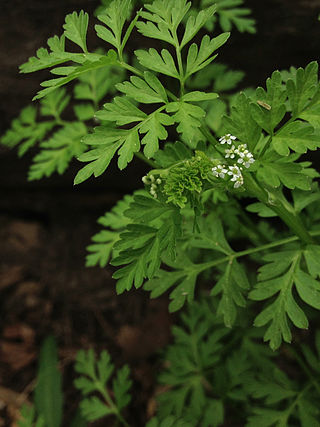
Chaerophyllum procumbens, known by the common names spreading chervil and wild chervil, is an annual forb native to the eastern United States and Canada, which produces small white flowers in spring.

Erythranthe lutea is a species of monkeyflower also known as yellow monkeyflower, monkey musk, blotched monkey flowers, and blood-drop-emlets. It was formerly known as Mimulus luteus.



















